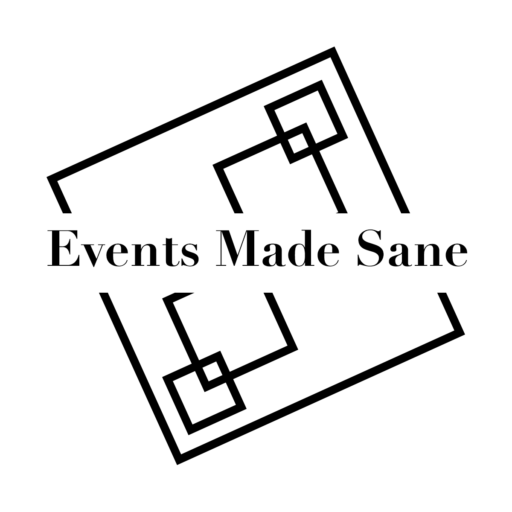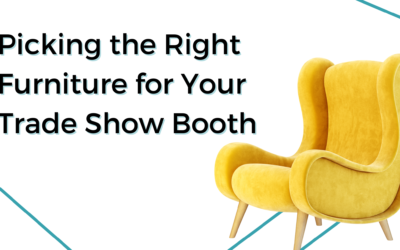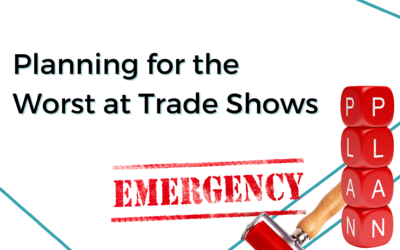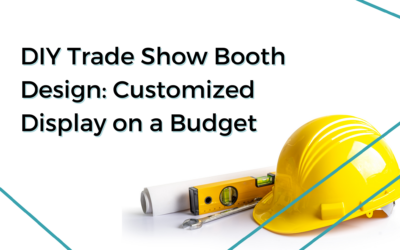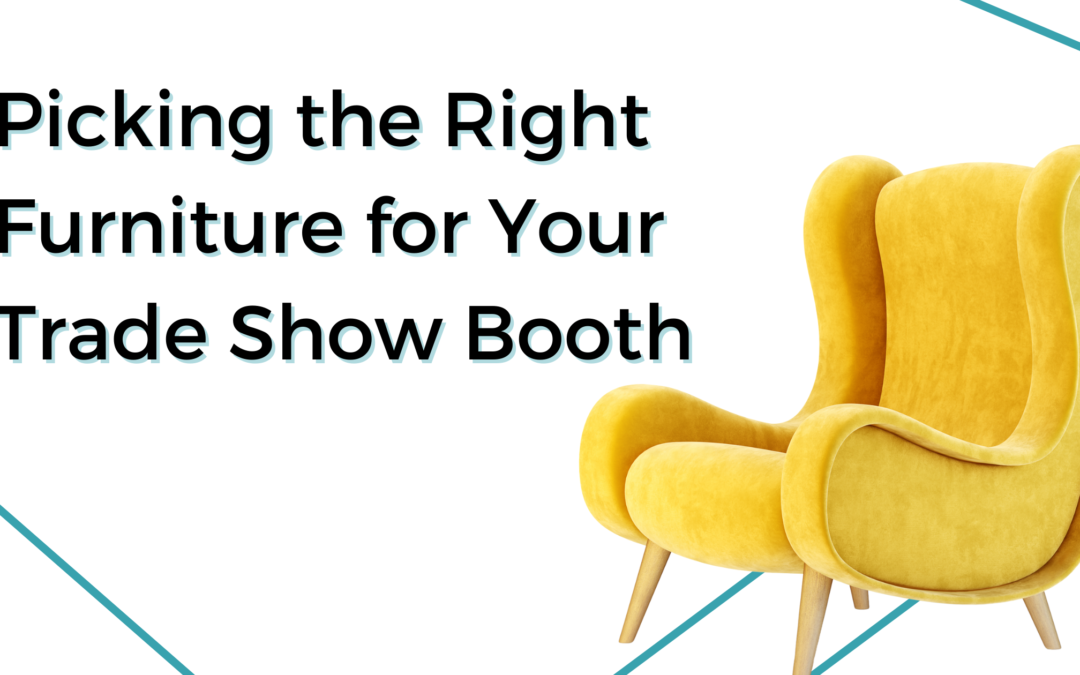
Business, Trade Show
Attending a trade show is an exciting opportunity to showcase your brand, connect with potential customers, and network with industry peers. However, creating a booth that stands out from the crowd requires more than flashy graphics and catchy slogans. Picking the right furniture can significantly enhance the functionality and appeal of your booth, ensuring that visitors feel comfortable, engaged, and impressed by your presentation.
Here’s how to pick the best furniture for your trade show booth.
Define Your Booth’s Purpose
The type of furniture you need depends on your booth’s purpose. Ask yourself:
– Will you be showcasing products or services?
– Are you focusing on face-to-face interactions or presentations?
– Do you want visitors to linger and interact, or are you aiming for quick exchanges?
For example, if your goal is to demonstrate products, display stands or shelving units might be essential. If you’re prioritizing conversations, seating arrangements such as lounge chairs or bar stools paired with high tables can create a more inviting atmosphere.
A quick note about seating is to make sure that your booth staff knows that it is no their to act as a desk for them to work from. The furniture is there for your booth guests. (Read about my Love/Hate Relationship with Chairs)
Optimize for Comfort and Functionality
Comfortable and functional furniture can make a big difference in how visitors perceive your booth. Attendees spend hours walking around trade show floors, so providing seating options can make your space a welcome retreat. Consider these tips:
– Chairs and Stools: Choose ergonomic options that balance comfort with aesthetics. Bar stools can create a modern and open feel, while lounge chairs provide a more relaxed vibe.
– Tables: Ensure you have surfaces for brochures, business cards, and interactive materials. High tables encourage standing interactions, while low tables work well in a lounge setup.
– Storage: Select furniture with built-in storage to keep the booth organized and clutter-free.
One note on comfy furniture is that you don’t want it too comfortable. You do not want people to linger longer than the needed conversations. You also don’t want random people sitting and enjoying it. So keeping the comfortable items towards the inner part of your booth will keep them out.
Align with Your Brand Aesthetic
Furniture should complement your brand. Sleek, minimalist designs might suit a tech company, while warm, wooden tones could work for a lifestyle brand. Use colors, materials, and shapes that align with your company’s logo and overall branding to create a cohesive and professional look. Customized accessories such as pillows or stool covers allow you to bring in your brand while renting from the trade show.
Prioritize Portability and Flexibility
Trade show furniture needs to be easy to transport, assemble, and disassemble. Lightweight, modular pieces are ideal for quick setup and takedown. Folding chairs, collapsible tables, and stackable stools are practical choices.
Take a moment to look at the cost of owning items versus renting them when planning. Consider the initial investment, storage cost, upkeep, and shipping costs in this analysis. Another option is to purchase furniture for each event and then find someone to donate the items to for out of town events.
The right furniture can elevate your trade show booth, creating a functional and appealing environment that draws visitors in and leaves a lasting impression. By focusing on purpose, comfort, brand alignment, and practicality, you can design a booth that not only attracts attention but also supports your trade show goals.
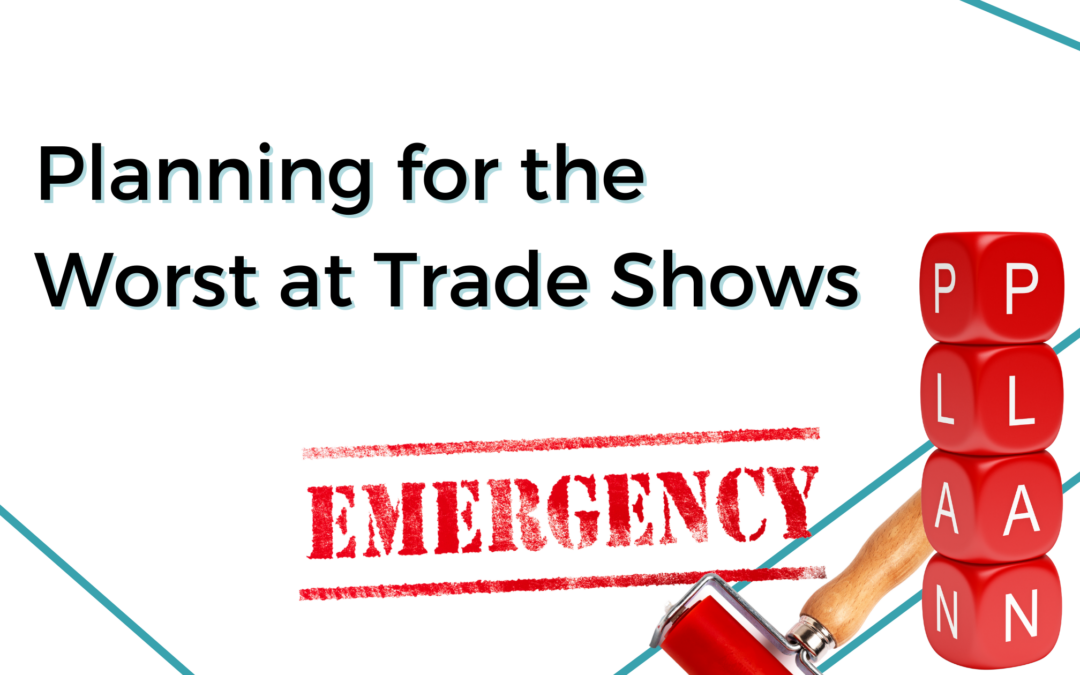
Business, Trade Show
Trade shows are a cornerstone of many industries, offering invaluable opportunities for networking, showcasing products, and generating leads. However, as any seasoned exhibitor knows, these events don’t always go as planned. From technical glitches to unforeseen emergencies, there are numerous potential pitfalls that can disrupt your trade show experience. That’s why it’s essential to have a solid contingency plan in place. In this blog post, we’ll explore some key strategies for planning for the worst at your trade shows.
Identify Potential Risks
The first step in effective contingency planning is to identify potential risks. These could include technical issues with your booth setup, transportation delays for your staff or materials, health and safety concerns, or even natural disasters if the event is located in an area prone to them. Take the time to brainstorm and make a comprehensive list of all possible risks.
Examples of Risks:
- Fire in your booth catching the whole show on fire.
- Someone tripping on the ripple in your carpet
- Someone having an allergic reaction to your catering food
- Computer virus that knocks out your entire demo system
- Political unrest causing travel issues or protests inside the venue
- Your booth not showing up or being shipped to the wrong address
- Union strike removing the labor needed inside the event center
I have seen or heard of all of the above happening. (Don’t forget to think about the risks off the trade show floor – Staying Safe at Out of Town Trade Shows)
Assess Impact and Likelihood
Once you’ve identified potential risks, assess their impact and likelihood. Some risks may have a minor impact and a low likelihood of occurring, while others could have a catastrophic impact and a higher likelihood. Focus your efforts on preparing for the risks that fall into the latter category, but don’t ignore the smaller ones entirely.
Develop Contingency Plans
For each identified risk, develop a detailed contingency plan outlining how you will respond if it occurs. This might include backup equipment or materials, alternative transportation arrangements, emergency contact information for key stakeholders, and protocols for communicating with attendees and staff in the event of an emergency.
Some contingency plans are easy – if your demos are knocked out, switch the power points that show the same thing but are not interactive.
Some plans require creativity – if your booth didn’t show up, how do you acknowledge that issue while also still showcasing what your company does? Can you do “community build booth”? Can your company overnight some backdrops? What rentals does the show have to help you fill in your space?
Most plans just require flexibility, creativity, and some acceptance.
Communicate with Your Team
Make sure everyone on your team is aware of the contingency plans and their roles in executing them. Conduct regular training sessions and drills to ensure that everyone knows what to do in an emergency. Encourage open communication and empower your team members to speak up if they notice any potential issues or risks.
Stay Flexible
While it’s essential to have a plan in place, it’s also crucial to stay flexible and adapt to changing circumstances. Be prepared to adjust your plans on the fly if necessary and remain calm and composed in the face of adversity. A positive attitude and a willingness to problem-solve can go a long way toward mitigating the impact of unexpected challenges.
Review and Update Regularly
Contingency planning is an ongoing process, not a one-time task. Regularly review and update your contingency plans to reflect changes in your business, industry, or the trade show landscape. Learn from past experiences and incorporate any lessons learned into your future plans.
Planning for the worst at your trade shows is essential for ensuring the success and safety of your team and your business. By identifying potential risks, developing comprehensive contingency plans, and staying flexible in the face of adversity, you can minimize the impact of unexpected challenges and maximize your chances of a successful trade show experience. Remember, the best-laid plans are those that are thoroughly prepared and regularly updated.
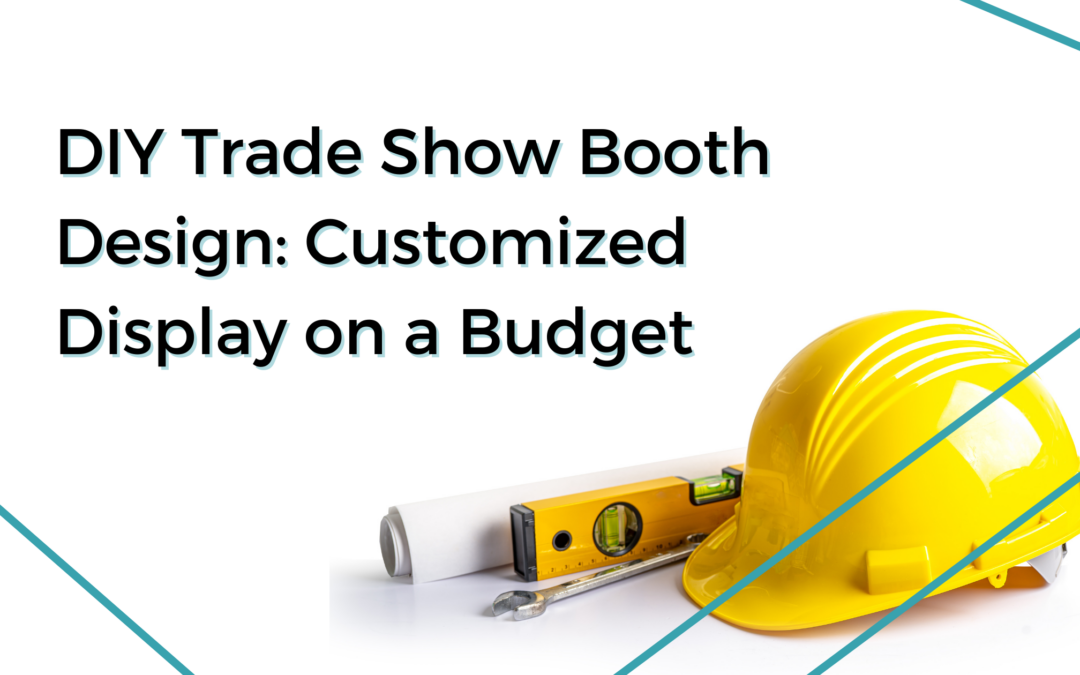
Business, Trade Show
Setting up a booth at events and exhibitions is a fantastic way to showcase your products or services, connect with potential customers, and boost brand visibility. However, creating an eye-catching booth doesn’t have to break the bank. With a bit of creativity and resourcefulness, you can design a customized display that stands out without exceeding your budget. Let’s explore DIY trade show booth design tips and tricks to help you create a visually appealing and memorable display for your next event.
1. Define Your Brand Identity
Before diving into the design process, it’s crucial to have a clear understanding of your brand identity. What message do you want to convey? What colors, fonts, and imagery represent your brand? By defining these elements, you can create a cohesive and consistent booth design that aligns with your overall brand image.
2. Repurpose and Recycle Materials
One of the most effective ways to stay within budget is to repurpose and recycle materials for your booth design. Look around your office or workshop for items that can be transformed into display elements. Wooden pallets, old furniture, or even discarded materials can be repurposed to create unique and environmentally friendly booth components.
One of my most successful 10 x 10 booths, we used products from our customers, even used their displays. We were able to created different levels on our table by using file boxes draped in white table cloths. This booth showcased the clients range of customers that they worked with, gave them free products to display in the booth, and allowed them to provide marketing for their customers as well.
3. Create a Focal Point
A well-designed booth should have a focal point that captures the attention of visitors. This could be a large banner, a striking product display, or a captivating visual element. By directing attention to a central feature, you make it easier for attendees to remember your booth and your brand.
A photo booth using a table and a ring light with a fun backdrop is very affordable. Eye catching graphics are another inexpensive way to create the focal point.
4. Utilize DIY Signage
Signage is a crucial aspect of booth design, and it doesn’t have to be expensive. Create your own signage using affordable materials like foam board, plywood, or even cardboard. Use large, bold fonts and vibrant colors to ensure your message is easily readable from a distance. Consider incorporating your logo and brand colors to maintain consistency with your overall branding.
5. Embrace Modular Design
Modular booth designs offer flexibility and cost-effectiveness. Create modular elements that can be rearranged or combined in different ways to suit various event spaces. This adaptability not only saves money but also allows you to customize your booth layout for different occasions.
6. DIY Lighting Solutions
Lighting can dramatically enhance the visual appeal of your booth. Instead of investing in expensive lighting fixtures, explore DIY lighting solutions. Use string lights, LED strips, or even repurpose household lamps to create a warm and inviting atmosphere. Experiment with different lighting angles to highlight specific areas of your booth.
Designing a booth on a budget doesn’t mean compromising on creativity or impact. By carefully planning, repurposing materials, and incorporating DIY elements, you can create a customized display that effectively communicates your brand message and attracts attention at events and exhibitions. Remember to stay true to your brand identity, focus on creating a focal point, and engage multiple senses to leave a lasting impression. With these tips and tricks, your DIY booth design can shine without breaking the bank.
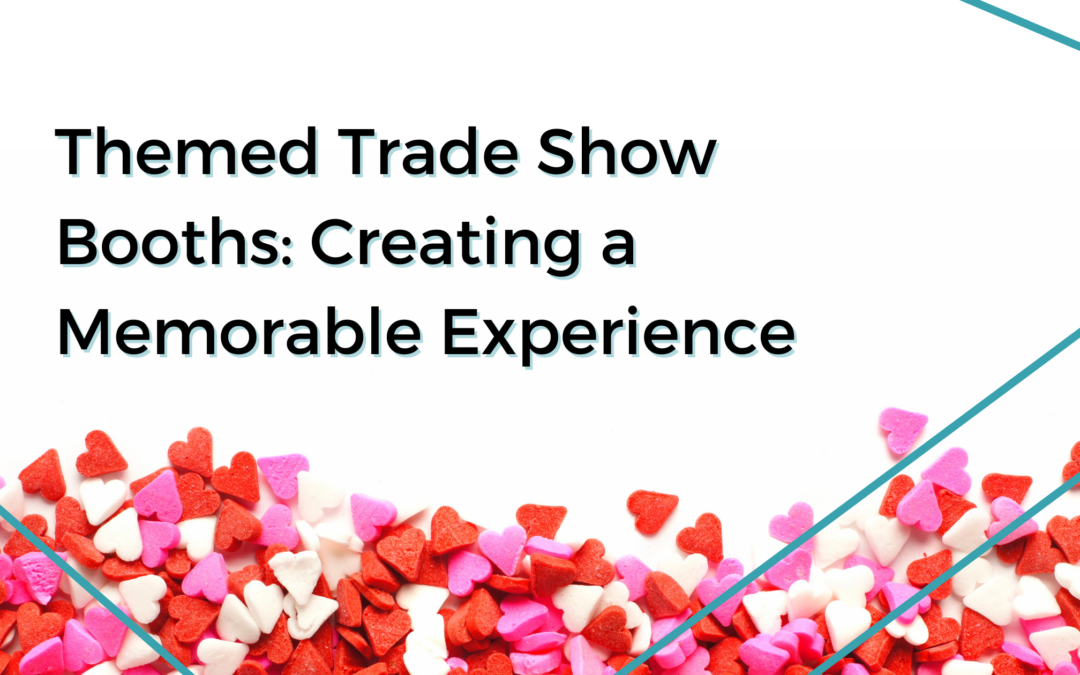
Business, Trade Show
Amid the sea of generic trade show booths, one strategy consistently captures attention and creates lasting impressions: the themed booth. When executed well, a themed booth transforms a simple display into an immersive experience that stays with attendees long after the event has ended. Here’s how themed booths can create a memorable experience around a central concept, and why they are worth considering for your next event.
Why Themes Matter
Themes provide a framework that ties together every element of your booth, from design and decor to activities and messaging. By focusing on a central concept, you can:
– Attract Attention: A creative and well-executed theme stands out in a crowded space, drawing people in through visual and emotional appeal.
– Reinforce Your Brand: A theme aligned with your brand identity can communicate your values, products, or services in a compelling way.
– Engage Visitors: Themed booths are inherently interactive and can encourage visitors to linger, participate, and learn more about your offerings.
– Create Buzz: Unique themes are memorable, making attendees more likely to share their experience on social media and with colleagues.
Steps to Designing an Effective Themed Booth
- Define Your Objective
Before diving into the creative process, clarify what you want to achieve with your booth. Are you looking to generate leads, increase brand awareness, launch a new product, or simply make a strong impression? Your objectives will shape your theme and execution.
- Choose a Relevant Theme
Your theme should align with your brand and resonate with your target audience. Consider the following approaches:
– Industry-Specific Themes: For example, a tech company might use a futuristic theme, while a food brand might go with a farm-to-table concept.
– Pop Culture References: A theme inspired by popular movies, TV shows, or trends can capture attention and foster immediate connections.
– Seasonal or Holiday Themes: Tie your booth to the time of year or a specific holiday to make it timely and engaging. I have worked the World Ag Expo and most of the time, Valentines Day happened during this event. While Ag and Valentines Day are not themes you would normally bring together, I always had fun coming up with concepts around the holiday.
– Storytelling Themes: Build a narrative around your products or services that attendees can explore as they visit your booth.
- Design Your Space
The design of your booth is the backbone of your theme. Every detail should work together to bring your concept to life:
– Visual Elements: Use cohesive color schemes, signage, and props to create an immersive environment.
– Interactive Features: Add hands-on elements like games, product demonstrations, or virtual reality experiences to engage visitors.
– Costumes and Staff Attire: If appropriate, have your staff dress in theme-related costumes to reinforce the atmosphere. I attended one show where all the booth staff was in ballgowns. Another show, the staff was in line green blazers. I still remember both of those booths and what their companies did.
- Engage Your Audience
Themed booths should encourage interaction and create opportunities for deeper connections. Some ideas include:
– Contests and Giveaways: Align prizes with your theme to encourage participation and leave a lasting impression. Falling back to the Valentines Day theme, give away Candy, Jewelry, flowers, or other items.
– Live Demonstrations: Showcase your products or services in action, tying them into your theme for added impact.
– Storytelling Opportunities: Share compelling stories or host mini-workshops related to your theme.
- Promote Your Booth in Advance
Maximize your booth’s impact by building anticipation before the event. Share sneak peeks on social media, invite key attendees to visit, and use hashtags or email campaigns to generate buzz.
Measuring Success
After the event, evaluate the effectiveness of your themed booth. Metrics such as foot traffic, social media mentions, lead generation, and attendee feedback can provide insights into how well your theme resonated and achieved your objectives.
A themed booth is more than just a decorative strategy; it’s an opportunity to create a memorable and meaningful connection with your audience. By carefully selecting a theme that aligns with your brand and executing it with attention to detail, you can elevate your event presence and leave a lasting impression. Whether you’re a small startup or a global corporation, the power of a well-designed themed booth can help you stand out and achieve your goals.
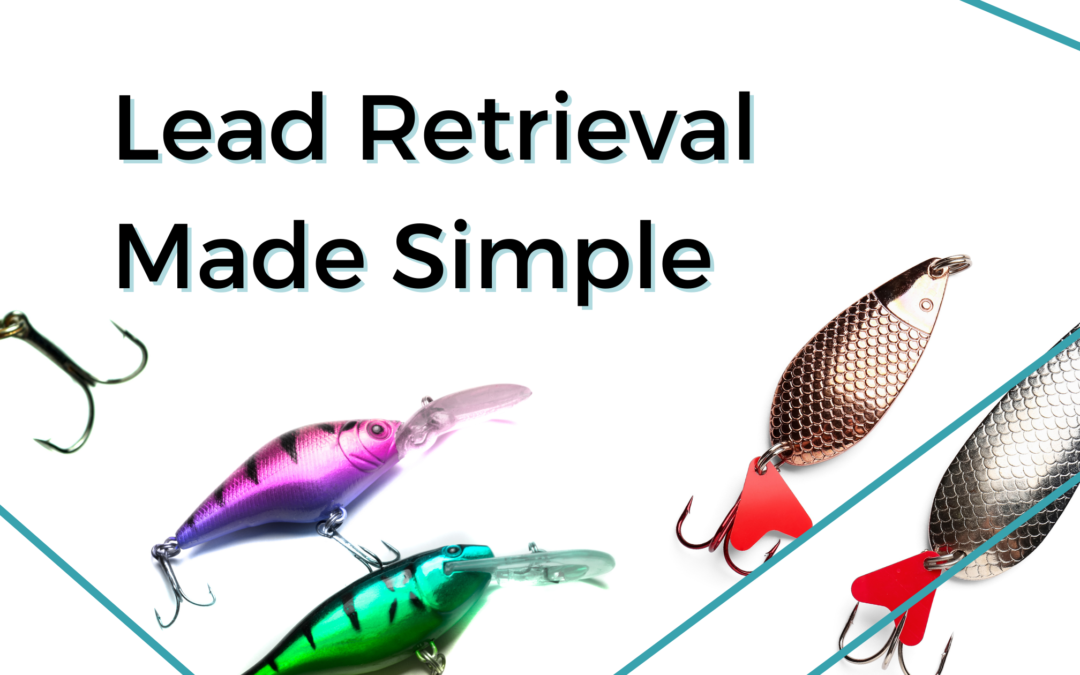
Business, Trade Show
Capturing, tracking, and nurturing leads at a trade show is more than just a stack of business cards or quick conversations. This is where lead retrieval comes in. Lead retrieval systems can help you engage with attendees, ensure no opportunity slips through the cracks, and, ultimately, drive sales. Here’s a quick guide to making lead retrieval simple and effective at trade shows.
What Is Lead Retrieval?
Lead retrieval is the process of capturing, storing, and managing potential customer information at an event. Traditionally, exhibitors collected business cards or noted down contact details manually. Today, digital systems allow exhibitors to scan badges, record details instantly, and follow up properly—ultimately converting conversations into real business opportunities.
Steps to Simplify Lead Retrieval at Trade Shows
Here’s a straightforward approach to maximizing lead retrieval efficiency before, during, and after the event.
Pre-Event Preparation
– Choose the Right Lead Retrieval Option: Most shows have a dedicated lead retrieval system and using these is the best idea for most small businesses. Figure out what your budget is and what options fall within it. (To learn how many people you need in your booth sign up for my course Effective Trade Shows for Small Businesses)
– Define Your Goals: Outline your goals for the number and quality of leads you wish to gather. This can help your team understand what they’re working toward and what to prioritize.
– Train Your Team: Make sure your team understands how to use the lead retrieval too. Practice using the app, discuss how to engage visitors, and train on inputting notes accurately.
– Customize Lead-Qualification Questions: Many lead retrieval systems allow for custom questions. Tailor these questions to get key insights—like project timelines, budget expectations, and role within their organization—that help qualify leads.
During the Event
– Engage Attendees with Purpose: Instead of merely scanning badges, engage visitors in a brief conversation. Understanding their needs allows you to tailor your pitch and qualify them better as leads.
– Take Notes in Real-Time: Use your app to take quick notes on the conversation, including key points or action items discussed. These notes are crucial during follow-ups when a personalized message can make all the difference.
– Categorize and Prioritize Leads On-Site: As you scan badges and take notes, tag or categorize leads based on priority. This way, high-potential leads are easy to spot post-event and can be followed up quickly. You can also note the “trick or treaters” that are just looking for swag.
Post-Event Follow-Up
– Export and Review Lead Data: Once the event ends, export the lead data to your CRM or database for immediate access. Review leads based on priority tags and ensure all information is accurate.
– Personalize Follow-Ups for Priority Leads: Personalization is key. Use the notes and tags from your retrieval app to segment leads based on their interest level and personalize follow-up messages. A well-tailored email or call can set your business apart and demonstrate your attentiveness.
– Timely Follow-Up Is Essential: Follow up within 24-48 hours of the event while your interaction is still fresh in the attendee’s mind. Automated email sequences are helpful, but a personalized message will resonate better for high-priority leads.This is where the segmentation onsite comes in.
– Measure Your Success: After the event, track metrics like conversion rates, engagement levels, and revenue from trade show leads. Assessing the quality and effectiveness of leads captured will guide improvements for future events. Also take a look at your actuals versus your goals. (Don’t forget the Post Event Survey)
Lead retrieval at trade shows doesn’t need to be complicated. With the right tools and a strategic approach, businesses can capture valuable attendee information efficiently, improve follow-up quality, and maximize trade show ROI. From pre-event planning to post-event follow-ups, a simplified lead retrieval process empowers exhibitors to focus on what matters: building relationships and closing deals.
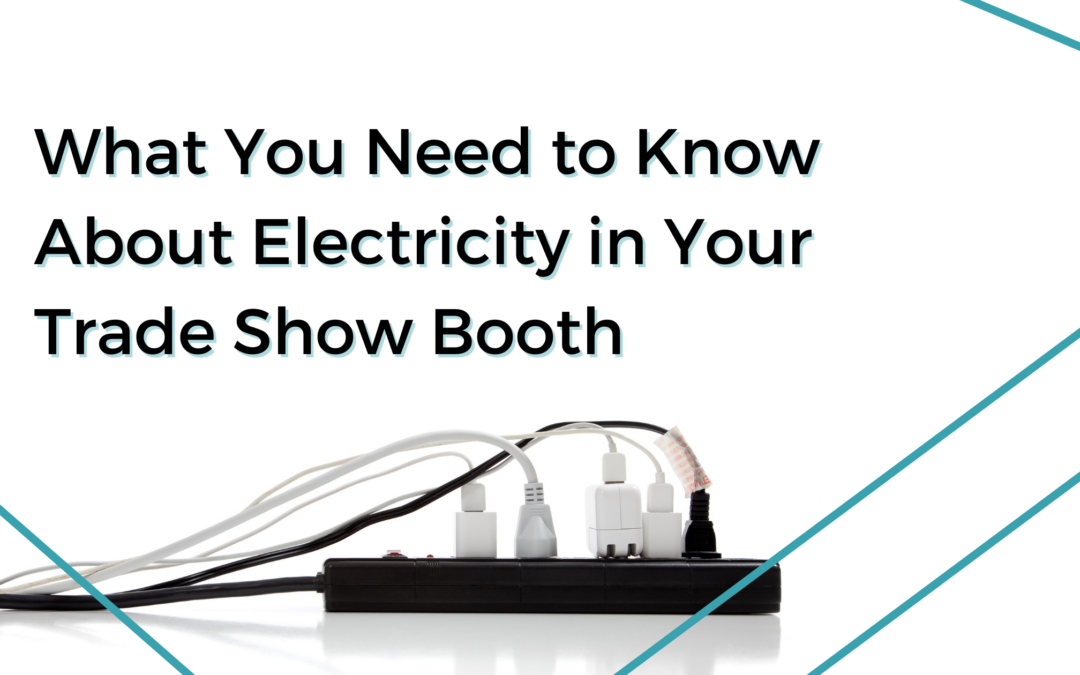
Business, Trade Show
Electricity is the lifeblood of any trade show booth, powering everything from lighting and displays to interactive demonstrations and charging stations. However, managing the electrical setup for your booth requires thoughtful planning and attention to detail. A misstep can result in equipment failure, safety hazards, or unnecessary costs. This guide will help you understand the key considerations for setting up electricity in your trade show booth effectively and safely.
1. Assess Your Power Requirements
Before designing your booth, determine what electrical resources you’ll need. Consider these factors:
- Devices and Equipment: List every device you’ll be using, such as monitors, lights, sound systems, or charging docks. Make sure you add in capacity for people who need to charge their phones or computers that are suddenly being used for sales presentations
- Power Consumption: Check the wattage or amperage requirements for each device to calculate the total load.
- Special Connections: Identify if any devices need unique plugs, outlets, or voltage converters.
Having a clear understanding of your power needs will prevent overloads and ensure a smooth setup.
2. Know the Venue Regulations
Trade show venues often have strict guidelines for electrical setups. To stay compliant:
- Obtain the venue’s electrical specifications and review them thoroughly.
- Determine if the venue requires licensed electricians to handle wiring or inspections.
- Submit any required plans or requests for additional power ahead of deadlines.
Failing to follow these rules could result in delays, extra fees or even being asked to leave the show floor.
3. Use Reliable, High-Quality Equipment
Cutting corners on equipment can lead to safety risks and device malfunctions. Instead:
- Invest in surge protectors and power strips with built-in circuit breakers to protect against power surges.
- Use commercial-grade extension cords that can handle heavy loads without overheating.
- Choose LED lighting for energy efficiency and reduced heat output. (Learn more about lighting in your booth.)
4. Prioritize Electrical Safety
Safety is non-negotiable when it comes to electricity. Follow these precautions:
- Inspect all equipment for damage, such as frayed wires or loose connections, before use.
- Avoid daisy-chaining multiple power strips or overloading outlets, as this increases fire risk.
- Secure cords with tape or covers to maintain a clean and professional appearance while prioritizing safety.
5. Test Your Setup in Advance
Don’t leave things to chance on the day of the event. Test your entire electrical setup beforehand:
- Ensure all devices power on and operate correctly.
- Confirm that outlets, cords, and connections are functioning as expected.
- Walk through the booth to identify and resolve any safety or performance issues.
Electricity is a critical element of any successful trade show booth. Proper planning, adherence to venue regulations, and an emphasis on safety will ensure a professional and hassle-free experience. By understanding your power requirements, using quality equipment, and thoroughly testing your setup, you can focus on what matters most: creating a booth that captivates and engages your audience.

